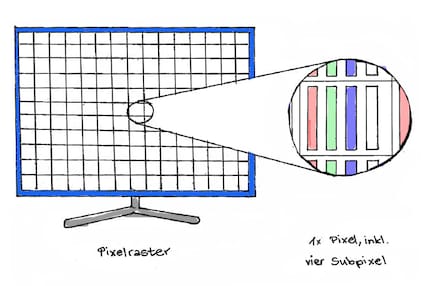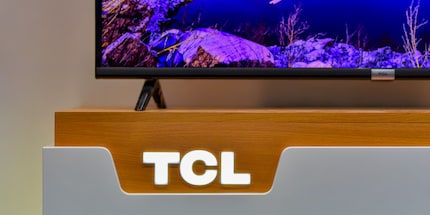
Background information
OLED vs. QLED: battle of the TV technologies
by Luca Fontana

The Chinese tech company TCL wants to conquer the OLED market. To this end, it is teaming up with the joint venture JOLED. Mass production is set to begin within the next three years.
TCL, the Chinese tech company, wants to produce large-area OLED panels in the near future. This reveals TCL's co-operation partner: JOLED.
JOLED Inc. [...], which develops, manufactures and sells OLED displays, announces the conclusion of a capital and business alliance with TCL CSOT, [...] a subsidiary of the Chinese high-tech company TCL.
The innovative production process is particularly exciting: The OLED layer is to be printed on a wafer-thin layer of glass, comparable to colour on paper in an inkjet printer.
The fact that the announcement has come at this time is nevertheless surprising: TCL is currently making positive headlines with its mini-LED technology intended for LCD televisions. In other words, one of the technologies that will one day replace OLED, if those manufacturers who do not sell OLED televisions have their way.
But the mission seems clear: TCL and JOLED want to set themselves apart from the OLED monopolist LG Display, from which all OLED TV manufacturers source their OLED panels - including Sony, Philips and Panasonic.
First, a bit of trivia so we're all talking about the same thing: What exactly is an OLED TV?
Unlike conventional LCD televisions, OLED TVs do not require a backlight. Their LEDs are so small that they are not only a light source but also a pixel. Technically speaking, carbon compounds are made to glow with electrical impulses. Hence the name: OLED, meaning "organic light emitting diode".
An OLED pixel consists of several sub-pixels. LG has four of them:

Together they form the image. Thanks to the additional white subpixel, LG's OLED TVs achieve a good overall brightness. However, the colour volume is limited at high brightness levels.
In contrast to LG's OLED displays, the printed OLED screens from TCL and JOLED use an RGB pixel matrix - without the white subpixel. The OLED pixels produced using the printing process should nevertheless shine just as brightly as LG's and at the same time have more colour volume. How? We're still in the dark; nobody knows the details.
Apropos: JOLED is a joint venture that includes well-known brands such as Sony, Panasonic and Japan Display. It was founded in 2015 to research the production of OLED displays using printing technology. Until now, JOLED has only been able to produce printed OLED displays in smaller formats - 21.6 and 32 inches. They are primarily used in the medical sector.
Although JOLED has always spoken out against the production of large-format printed OLED screens in other words 65 inches or larger, the cooperation with TCL has materialised. After all, the Chinese TV manufacturer is investing around 281 million US dollars in JOLED's know-how and will also receive ten per cent of its shares.
TCL is not (yet) very well known in this country. No wonder: the Chinese company based in Shenzhen, Guangdong, is relatively young by industry standards. Founded in Hong Kong in 1981, it produced cheap counterfeit cassettes under the name TTK. Four years later, TTK was sued for intellectual property infringement. As a result, it changed its core business and its name: Telephone Communication Limited. TCL for short.
TCL is now the th largest manufacturer in the world in terms of televisions sold. And thus probably the fastest growing TV brand. Only Samsung and LG currently sell more TVs per year.
TCL's great pride and joy: its Vidrian Mini LED technology.
In short: Mini LED stands for thousands of closely spaced LEDs that provide the background light. The only difference to Full Array Local Dimming (FALD) is the number of dimming zones: Top FALD models come with around 500 dimming zones. TCL's first generation of mini LED TVs manages around 1000.
In combination with nanoparticles, which are called Quantum Dots like Samsung's, i.e. "QLED", TCL's mini LED TVs should offer almost as good black levels as LG's OLED TVs. On the TCL homepage, there is even talk of "true black", i.e. "True Black". At the same time, the mini LED televisions should shine brighter and not suffer from burn-in.
Great words, TCL. Big words.
Despite QLED televisions with advanced backlight technology, TCL clearly does not want to leave the OLED market to the competition. At least not without a fight. That would seem surprising if there wasn't a but. I'll get to that later. In any case, TCL used rather uncharming words in favour of OLED technology at the last CES 2020 in Las Vegas:
Unlike the older, self-illuminating TV technology [OLED], which struggles with bright rooms and the intensive use of games consoles, our mini LED TVs deliver outstanding contrast and bright images for every purpose.
The fact that TCL refers to OLED as "older TV technology" is no coincidence. In fact, I spoke to TCL employees about a year ago about the company's future plans and strategies. Their key message: OLED technology has been around for ten years and is therefore nearing the end of its development cycle.
In figures: OLED has around 5000 registered patents so far - experts expect a total of 5500 to 6000 patents. QLED technology has only 600 registered patents - around 8000 patents are expected before QLED is at the end of its cycle. This means that it is not OLED, but QLED, which is only around three years old, that is the TV technology of the future.

But here's the thing: the employees assured me that TCL wanted to stay on the ball with both technologies - OLED and QLED - despite OLED concerns. What's more. TCL even wants to produce QLED televisions with self-illuminating pixels from 2022 - in other words, build a hybrid of QLED and OLED technology.
At the time, TCL employees still called this "H-QLED". In the meantime, I suspect the technology behind it is the one that Samsung is currently working on at full speed and which would even mean the general end of LCD screens for the South Korean TV manufacturer: Quantum Dot OLED. In short: "QD-OLED".
So it is not surprising that TCL wants to challenge the other South Korean TV manufacturer, namely LG, in the OLED market. What is surprising is the chosen production process. Precisely: the JOLED printing process. Nobody is talking about a QLED/OLED hybrid anymore.
Unless TCL is working on both technologies. And QLED. And mini LED. And Micro LED.
Such an aggressive and expensive research and development strategy speaks for damn high ambitions. TCL probably wants to challenge Samsung for the top spot in terms of TV sales - and soon.
The question remains as to whether LG will soon be put in its OLED place. Beaten on their home turf, so to speak. Well, probably not. Certainly not any time soon.
Because LG is counting on its years-long head start in research and manufacturing processes. TCL has to catch up first. What's more, the South Korean TV company with its production facilities in Guangzhou to achieve even more mass production - and therefore lower prices. Probably one of the most important purchasing criteria for potential customers.
If you don't want to miss news and background information about the world of cinema and television, then follow me by clicking on the "Follow author" button.
Header image: Polina MB / Shutterstock.com
I write about technology as if it were cinema, and about films as if they were real life. Between bits and blockbusters, I’m after stories that move people, not just generate clicks. And yes – sometimes I listen to film scores louder than I probably should.
From the latest iPhone to the return of 80s fashion. The editorial team will help you make sense of it all.
Show all